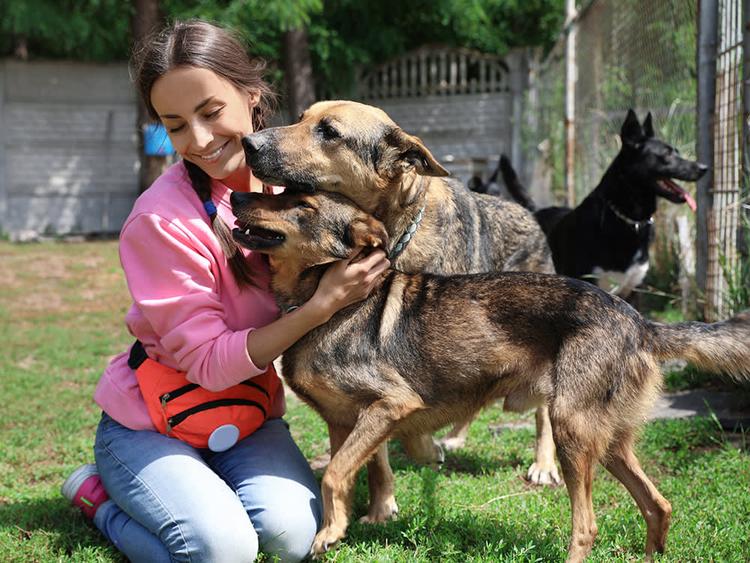Adopting a Diabetic Dog and Giving Them a Second
While you’ll need to monitor your pet’s blood sugar, it’s not nearly as involved as you’d think.
While you’ll need to monitor your pet’s blood sugar, it’s not nearly as involved as you’d think.
by Adrienne A. Kruzer, BBA, RVT, LVT, | June 10, 2024

Alice Nerr / Stocksy
Adopting a diabetic dog can be a life-changing experience, both for the dog and the adopter. While this comes with additional responsibilities and a commitment to managing the dog’s health, opening your heart and home to a diabetic dog can lead to a deeply rewarding bond. In fact, once you understand what caring for a diabetic dog fully entails, it may not seem so daunting at all.
Yes, dogs can get diabetes — and there are actually two types of canine diabetes. As with people and cats, dogs can have either type I or type II diabetes mellitus, but type I diabetes mellitus is the most common kind of diabetes in dogs.
Normally, a dog’s pancreas produces insulin to naturally regulate blood-sugar levels in their body. However, when a dog has type I diabetes, special cells in the pancreas called beta cells stop functioning properly, and no longer produce this hormone. This form of diabetes may also be referred to as juvenile-onset or insulin-dependent diabetes. But no matter what you call it, it means a dog’s body cannot produce the insulin they need due to an autoimmune issue. There is no cure for type I diabetes mellitus in dogs, but administering insulin injections can help mitigate it.
In contrast, type II diabetes mellitus is very rare in dogs. When a dog has type II diabetes, their pancreas still produces insulin, but not enough to meet their body’s needs. This lack of adequate insulin production is not due to an autoimmune issue, but instead a result of obesity, steroids, or hormonal abnormalities. Some dogs with type II diabetes can go into remission. If you’re wondering, “How long can a dog live with diabetes?” you’re in for some good news: Diabetes caught early and properly treated should not affect your dog’s lifespan.
Considering adopting a diabetic dog? The good news is, with proper management, their care can be straightforward and rewarding. Still, before you bring your dog home, gather as much information as you can from the shelter about your dog.
If you’ve decided to adopt a diabetic dog from a shelter, you’ll want to know basic but important information to manage their health. Not every person in the shelter may have the answers to these questions, but be sure to find someone who can get you the information (and the insulin) you need before you leave.
When and where did they administer the insulin?
Insulin needs to be given to your dog at two specific times during the day. These times are typically 12 hours apart and about half an hour after your dog eats a meal. If insulin is administered at the incorrect times, your dog’s blood sugar may get too high or too low, both of which can be problematic.
Insulin is typically administered under the skin with a special insulin syringe and needle, so you’ll need to know where on the body your dog is used to getting these tiny injections. This helps maintain consistency and expectations with your dog, instead of adding more changes to their life as they become part of your family.
What kind of insulin is given?
Most dogs will use products called Vetsulin®, Caninsulin®, Humulin®N, or detemir (brand name Levemir®), but some will take glargine (brand name Lantus®) or protamine zine (brand name ProZinc®). These different types of insulin are not always interchangeable. That’s why it is very important to know what kind of insulin your dog has been getting.
How is the insulin stored and prepared?
Most insulin needs to be stored in the refrigerator, but it is important to ask the shelter how they store the specific type of insulin your dog will be getting. In addition to refrigeration, the insulin may also need to be carefully mixed, instead of shaken, in a manner that does not deactivate the product — so you should also ask them how they prepare the insulin.
How much insulin is given?
This is probably the most important question to ask the shelter when adopting your new dog. Insulin dosages are unique to each dog and can change over time. You’ll need to know how many units of insulin your dog currently receives, along with the type of insulin syringe you should use. Insulin syringes come in two sizes, U-100 and U-40, and using the wrong kind of syringe will result in the incorrect amount of insulin being given.
Although it’s not difficult to care for a diabetic dog, there are some special considerations you need to take into account to keep them healthy.
If you’re wondering, “What food causes diabetes in dogs?” — you’ll be happy to know that there are no specific diets that will give your dog diabetes. There are, however, specific dog food options to help manage your dog’s diabetes. These foods are typically high in fiber. Your veterinarian is the best resource to learn which food might be the most therapeutic for your dog.
When it comes to feeding a diabetic dog, the most important thing to remember is to be consistent in what you feed. Regardless of which kind of food or treats you feed your dog, be sure they’re the same each day because what your dog eats can affect how much insulin they require.
Regular vet visits, bloodwork, insulin and syringes, a glucometer, and, of course, food and all things your diabetic dog will require.
The cost of insulin depends on how much your dog needs daily: It can be as little as $1 to 2 a day or up to $4 to 5 a day if you have a large dog who requires several units of insulin. It’s best to also keep a glucometer at home in case you need to check your dog’s blood sugar. These handheld machines are typically a one-time cost of around $50 and only need occasional refills of lancets and testing strips.
Food costs will depend on what kind and how much food your dog eats. Finally, budget for vet visits with blood work every six months.
If you have a diabetic dog, you’ll want to know which symptoms indicate that your dog has a blood-sugar problem.
Lethargy, vomiting, disorientation, a loss of appetite, weakness, fainting, seizures, and lack of coordination are symptoms of concerningly low blood sugar. This can occur if your dog doesn’t eat but still receives insulin, or if your dog is receiving too much insulin. Use your glucometer to check your dog’s blood sugar levels. If it’s low and they won’t eat, rub corn syrup or honey on their gums and contact your veterinarian.
You should also look out for signs that your dog’s blood sugar is too high. These include drinking a lot of water, urinating excessively, weight loss, and vision loss. If your dog exhibits any of these symptoms, contact your veterinarian.
Your first year as a pet parent may cost anywhere from $420 to $3,270. Because the cost of having a dog can vary greatly, start with a budget of $2,000 for your first year. Monthly costs for a healthy dog may include flea, tick, and heartworm preventatives, as well as food and grooming. Annual or bi-annual costs include pet insurance, veterinary check-ups, and routine blood work. Those costs may go up if your dog has any health issues.
Pet insurance, which you should get immediately upon adopting your dog, will help reduce unexpected charges. You can also get short-term lines of credit and loans. And specific pet charities may be able to provide some financial help.
How Much Does a Vet Visit Cost?
Insulins for the Long-Term Management of Diabetes Mellitus in Dogs
What’s the Best Diet for My Dog with Diabetes?
Survival estimates in dogs with newly diagnosed diabetes mellitus

Adrienne Kruzer is an accomplished veterinary technician and writer with over 15 years of hands-on experience caring for domestic and exotic animals.

Shelters & Rescue

Adoption Advice

Adoption Advice

Shelters & Rescue
Debunk a few animal shelter myths and learn the benefits of adopting from a shelter or rescue group.

Adoption Advice
Find out how to set your adopted rescue dog up for success.

Adoption Advice
These studies prove that dogs’ awesomeness is more than just a vibe.

Shelters & Rescue
If you suspect animal cruelty in your community, here’s how you can help stop the mistreatment as soon as possible.

Adoption Advice
Not sure if you should adopt a younger or older pet? Here’s a guide to help you make the best decision.

Shelters & Rescue

Adoption Advice
Is the responsibility of taking care of your pet causing you to worry about your budget? Rest assured, there are a number of ways to minimize this financial stress.

Adoption Advice
Are you finalizing a new pet’s adoption? Learn everything you need to know about pet adoption paperwork.

Adoption Advice
Considering getting a pet but unsure if you want a cat or dog? Here are 10 differences to consider.